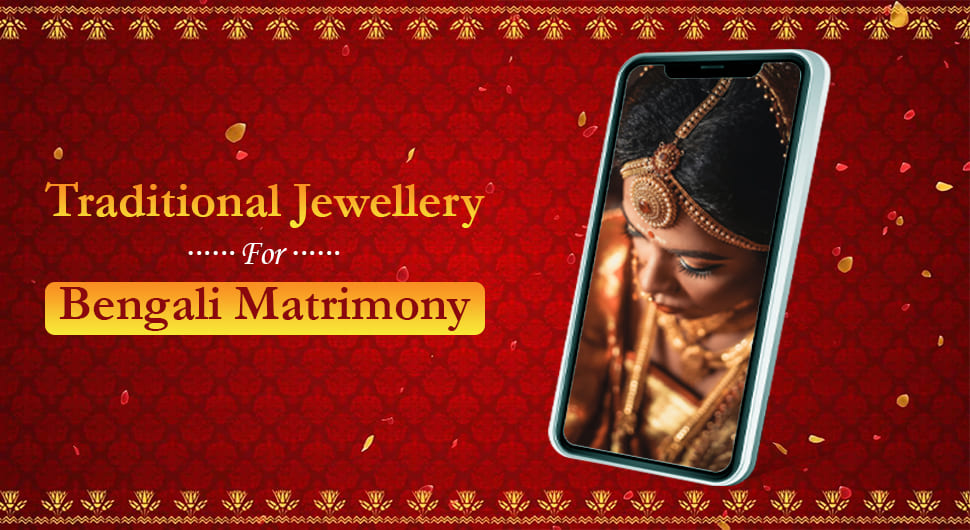Traditional Jewellery for Bengali Matrimony

Jewellery is an important aspect of the Bengali matrimony. It reflects the wealth, prosperity of the families that are getting married. Moreover, every bride enjoys dressing up on her special day and Bengali brides are no different. They love to deck themselves in their traditional attire and heirlooms.
Here is a list of the traditional jewellery types of West Bengal.
Traditional Bengali Bride and Groom Jewellery Types
Jewels for the Hair
The Bengali bride’s thick black locks are usually done up in a bun for the big day. To fasten the bun is the bun pin, which is a beautiful ornament made from precious gemstones and gold. It is a throwback to the rich heritage of Bengal’s zamindari past.
Apart from the bun pins, a tikli or the maang tikka is also worn. This ornament partitions the hair into two halves and is usually lifted when the groom applies the sindoor to the bride’s head. The tikli can be heavy or delicate depending on the bride’s tastes.
Jewels for the Head
On the head, the Bengali bride wears a sonar mukut or a golden crown, quite similar to the tiara of Western weddings. Nowadays, brides opt for faux gold or gold plated sonar mukuts. Wearing a sonar mukut in today’s day and age is considered a sign of wealth.
Jewels for the Ears
When it comes to the ears, the Bengali bride has a wide variety of to choose from. Some of them are:
- Kaaner dul: These are normal drop earrings that can come in heavy or light designs.
- Jhumko: Also known as jhumka in the North, are chandelier shaped earrings that are made of gold and floral patterns.
- Kaan Baala: This piece covers the whole ear, is very heavy and extensively crafted.
- Kaan Pasha: This is a stud earring made of gold and is inspired by floral patterns. Its circular shape is perfect for the round-faced Bengali bride.
Jewels for the Nose
For the nose, a gentle nath or nolok is worn. The ornament is designed with pearl or similar beads or with floral golden designs. Brides may also wear large nakchabi which is the stud version of the Nath.
Jewels for the Neck
Bengalis have their jewels for the neck which are uniquely crafted. Some of them are:
- Chik: The chik is a choker that does not touch the collar bone. This is available in gold, pearl and diamond forms.
- Pati Haar: This is a flat and broad neckpiece that is comfortable for most women to wear.
- Saath Noli Haar: This is a family heirloom that is worn by brides and is gifted by the bride’s mother or mother in law. It is a necklace of 7 chains and in case of 5 strings is known as Paanch Noli Haar.
Jewels for the Arms
Ananta or armlets are no longer as popular as they used to be owing to the increased price of gold. However, if you have inherited a piece from your mother or grandmother, you can surely wear then on your wedding day.
Wrists
The Bengali bride has many options for the wrists. Some of them are:
- Chur: These are intricately designed bangles that are usually thicker in size, covering the whole wrist.
- Ratanchur: The ratanchur is a bangle that has five rings attached to it. It is the heritage from the Mughal era and has a lotus, sun, or moon designed to the central part.
- Baala: Also known as kadas in other parts of the country, Baala is worn in pairs. They can also be used in regular wear.
- Mantasha: The mantasha is a mixture of pearls and gold jewellery.
- Bauti: The bauti is a half-cut bangle that is usually intricately designed.
- Kankan: Kankan has spike formations and gives a gorgeous look.
- Chudi: These are light bangles worn in stacks of 15 or 18 for a beautiful look.
- Apart from these, the brides also wear Shaka Paula and the Loha Bandhano.
Fingers
On the fingers, the Bengali bride and groom wear aangti or rings.
Waist
Similar to the vaddanam of South India, is the kamarbandh of Bengali weddings. It is intricately designed with floral or gold patterns.
Feet
On the feet, women wear nupur either in gold or silver.
Conclusion
A Bengali Matrimony is incomplete the traditional jewellery. It is a sign of blessing from the ancestors and it brings brides closer to their mothers and mothers-in-law. While others may see jewels as relics of the patriarchy, they can also be seen as the emblems of a liberated woman, making her own choice in the world.
